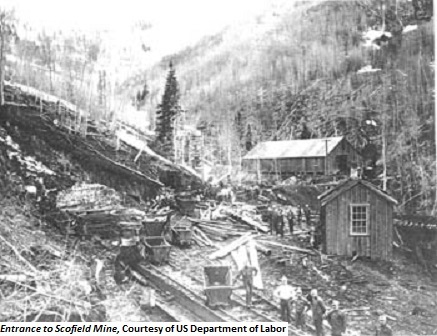Dublin Core
Title
Description
The death of two brothers in the Winter Quarters mining blast was made especially tragic by their recent success as a part of their family’s musical performance troupe.
In 1900, two brothers, David and Richard Evans, were killed in a tremendous explosion that rocked the Winter Quarters Number 4 mine near Scofield in Carbon County. The Evans brothers were only 2 of two hundred miners who lost their lives in the deadly Winter Quarters blast, but what makes their deaths so poignant is the fact that they had recently begun to achieve local fame as part of their family's musical performance troupe.
The Evans family immigrated to Utah from their native Wales, where Isaac, David and Richard's father, had honed his skills as a poet and musician and their mother had developed a reputation as a talented vocalist. Upon reaching Utah, the Evans family put down roots in Castle Dale, and Isaac and his sons—five in all—worked as coal miners.
Mining, however, seems to have been just a way to make ends meet for the Evanses. Their true passion was music. According to a contemporary observer, the Evans family singers were consummate professionals. Not only had they won several prestigious local awards for their fine musical talents, the observer noted, but they had the "best orchestra" in the Emery County area.
Such positive reviews of their music make the loss of David and Richard Evans in the Winter Quarters tragedy all the more unfortunate. Ironically, they appear to have survived a mine explosion eighteen years earlier while still living in Wales. But they weren't so lucky in Utah. The personal impact the brothers' deaths had on their family is hard to detect from historical sources, but it’s not hard to imagine that it hurt them deeply. It’s possible to even speculate that their deaths contributed to their father's passing not even a year later in Castle Dale.
Creator
Source
Image: Miners stand among splintered timbers and other debris at the entrance to No. 4 mine shaft, background left, where the explosion is believed to have originated. By the time this photo was taken, much of the debris had been cleared from the portal and engine house by rescue and recovery teams. Courtesy of US Department of Labor.
_______________
See Edward A. Geary, A History of Emery County (Salt Lake City: Utah State Historical Society and Emery County Commission, 1996), 158-159; J. W. Dilley, History of the Scofield Mine Disaster (Provo, Utah: Skelton, 1900); and Nancy J. Taniguchi, Castle Valley, America: Hard Land, Hard-Won Home (Logan: Utah State University Press, 2004), 109.

